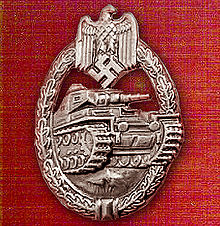Panzer Badge
The tank combat badge was an award for soldiers of the tank and their support troops at the time of the Second World War . It was donated on December 20, 1939 by Colonel General Walther von Brauchitsch and initially still bore the name Panzerkampfwagenabzeichen , which was renamed a year later and from then on bore the name Panzerkampfabzeichen .
Tank battle badge in silver
The silver tank battle badge was the first of its kind to be donated. It could be awarded to all soldiers of the armored forces. The prerequisite was the probation in three different combat missions, on three different days as a member of a tank crew . This must have actively participated in the fighting.
Panzer badge in bronze
The bronze tank battle badge was donated by Brauchitsch on June 1, 1940 and was intended as recognition of the proven performance of all parts of the army in many assault attacks and as an incentive for the fullest commitment of the individual man . It was therefore comparable to the infantry assault badge for the motorized infantry. The award regulations were similar to that for silver. However, a soldier who was awarded the bronze tank battle badge must have participated in three different assault attacks with the weapon in the front position.
Award numbers
The tank combat badge could initially only be awarded by division commanders , but from September 9, 1942 also by battalion commanders . The award numbers (including higher levels) for the tank combat badge were:
- about 22,000 (silver)
- about 12,550 (bronze)
Carrying method
The tank battle badge was worn as a plug-in badge on the left side of the chest in and out of service with all uniforms of the Wehrmacht. It could also be worn with all party and state uniforms. A reduced form (16 mm needle) of the award on the left lapel of the skirt was allowed to go with bourgeois clothing. A corresponding miniature pendant to the tailcoat chain was allowed on special occasions.
stages
Originally donated only in one level, the further course of the war finally made it necessary to create higher levels for the tank combat badge (both in silver and bronze). This was due to the fact that more and more members of the armored forces and their subordinate units had over-fulfilled the conditions for awarding the armored combat badge. With an order of June 22, 1943, the Army High Command finally approved its introduction. The resulting grading was:
- Tier: Panzer Badge
- Level: Panzer Badge with mission number 25
- Tier: Panzer Badge with mission number 50
- Level: Panzer Badge with mission number 75
- Level: Panzer Badge with mission number 100
From then on, the tank battle badge in silver was reserved for the tank crews of the tank units and the tank battle badge in bronze was reserved for the tank crews of the tank reconnaissance units. Members of the assault gun units, the assault tank units and tank destroyer units of the tank destroyer departments were only awarded the general assault badge .
Others
According to the law on titles, medals and decorations of July 26, 1957, wearing the version of the Third Reich in the Federal Republic of Germany is only permitted without National Socialist emblems. The beret badge of the armored troops of the Bundeswehr , derived from the model of the 57 version of the armored combat badge of the Wehrmacht, also uses a stylized battle tank (leopard) , which, however, in contrast to its model, with the opposite direction of travel (driving from right to left, due to the way the beret is worn ) is pictured. Incidentally, the flag of the Federal Republic of Germany can be seen here instead of the number of operations .
literature
- Heinrich Doehle : The awards of the Greater German Reich. Orders, decorations, badges. 5th edition. Erdmenger, Berlin 1945 (Reprint. Patzwall, Norderstedt 2000, ISBN 3-931533-43-3 ).
- Hans-Ulrich Krantz: Orders and decorations of the Federal Republic of Germany. Maximilian, Cologne 1958.
- Kurt-Gerhard Klietmann : Awards of the German Empire. 1936-1945. Motorbuch, Stuttgart 1981, ISBN 3-87943-689-4 .
- Army Ordinance Sheet. Part B, No. 82, 1939, Bl. 27, p. 393.
- Army Ordinance Sheet. Part C, No. 16, 1941, Bl. 8, p. 137, paragraph 211.




